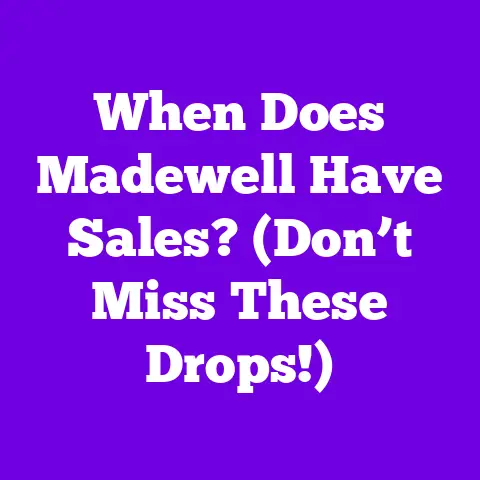When Are Mattresses Typically On sale? (Don’t Overpay!)
Living here in the heart of the Midwest, I’ve noticed a distinct rhythm to how we shop for big-ticket items like mattresses. It’s not just about needing a new bed; it’s about snagging the best deal possible. The price of a mattress can fluctuate wildly depending on the time of year, and knowing when to strike can save you hundreds, even thousands, of dollars. With 2025 on the horizon, it’s time to gear up with the insider knowledge you need to avoid overpaying.
Mattress shopping can be a daunting task. From innerspring to memory foam, and hybrid options galore, the choices are overwhelming. But the key to a good night’s sleep isn’t just the mattress itself; it’s also the peace of mind knowing you didn’t get ripped off. Sales events, regional shopping habits, and the overall market trends all play a significant role in determining the price you’ll pay. Understanding these factors is crucial for making an informed decision.
The central argument I’m going to explore is this: by understanding the timing of mattress sales, specifically tailored to our Midwestern shopping habits, you can save a significant amount of money and make a far more informed purchasing decision. So, let’s dive in and uncover the secrets to scoring the best mattress deals in 2025.
Understanding Mattress Sales
The mattress market is a multi-billion dollar industry, filled with a variety of options to suit every sleeper’s needs. From the traditional innerspring mattresses, which typically range from $300 to $1,000, to the increasingly popular memory foam options, priced anywhere from $500 to $3,000, the choices are abundant. Hybrid mattresses, combining the best of both worlds, can command prices from $800 to upwards of $4,000, depending on the brand and materials used. Knowing these price ranges is your first line of defense against overpaying.
Seasonal trends are the backbone of mattress sales. Certain times of the year are virtually synonymous with discounts. Memorial Day, Labor Day, and Black Friday are the holy trinity of mattress sales, offering some of the most significant markdowns you’ll see all year. Retailers use these holidays to clear out old inventory and make way for new models. For example, according to data from Sleepopolis, Memorial Day sales often see discounts of up to 60% off select mattresses.
Living in the Midwest, I’ve noticed that our shopping habits are influenced by a few key regional factors. For one, the climate plays a role. With long, harsh winters, many Midwesterners prefer to shop online from the comfort of their homes, leading to a surge in online mattress sales during these months. Local economy also matters; in agricultural states, the success of the harvest season can impact consumer spending. Moreover, regional holidays like State Fair days often bring special promotions and discounts from local retailers, including mattress stores. For instance, I’ve personally seen local furniture stores in Iowa offer “harvest season” discounts, coinciding with the corn and soybean harvest in the fall.
Let’s consider a specific example: a Queen-sized memory foam mattress from a popular brand might typically retail for $1,200. During a Memorial Day sale, that same mattress could be marked down to $800 or even lower. However, outside of these peak sales periods, the price could easily hover around the $1,100 mark. Understanding these fluctuations is vital for timing your purchase effectively.
Major Sales Events for Mattresses
National sales holidays are the big game for mattress shoppers. Here’s a breakdown of the most important ones:
- Presidents’ Day: Kicking off the year with significant discounts, Presidents’ Day sales in February are a great opportunity to snag a deal. Retailers often offer discounts of 20-30% off, plus freebies like pillows or mattress protectors.
- Memorial Day: As mentioned earlier, Memorial Day in May is a prime time for mattress sales. Discounts can reach up to 60%, and many retailers offer extended trial periods.
- Fourth of July: Following closely on the heels of Memorial Day, the Fourth of July offers another chance to save. Expect discounts in the 20-40% range.
- Labor Day: In September, Labor Day sales provide a final opportunity to snag summer closeouts. Discounts are similar to Memorial Day, often reaching 50-60%.
- Black Friday/Cyber Monday: The granddaddy of all sales events, Black Friday and Cyber Monday in November offer some of the deepest discounts of the year. However, be prepared for limited stock and fierce competition.
Retailer-specific sales are also worth noting. Brands like Sleep Number and Tempur-Pedic often have their own promotional events throughout the year. For example, Sleep Number frequently offers discounts on their smart beds during the summer months, while Tempur-Pedic often has clearance sales on older models in the fall. Online retailers like Casper and Purple are also known for their frequent online sales, offering discounts and freebies to attract customers. Brick-and-mortar stores like Mattress Firm and local furniture stores also have their own sales events, often tied to local events or holidays.
Don’t overlook local and regional sales events. In the Midwest, state fairs often feature vendors selling mattresses at discounted prices. Local furniture stores may also have “warehouse sales” or “clearance events” that aren’t widely advertised but can offer substantial savings. Keeping an eye on local newspapers, community bulletin boards, and social media groups can help you uncover these hidden gems.
To illustrate, let’s consider a specific retailer: Mattress Firm. According to their historical sales data, they typically offer the following discounts during major sales events:
| Sales Event | Average Discount |
|---|---|
| Presidents’ Day | 25% off |
| Memorial Day | 40% off |
| Labor Day | 35% off |
| Black Friday | 50% off |
Timing Your Purchase
Taking all the information into account, here’s a consolidated list of the best times to buy a mattress, particularly with a Midwestern focus:
- Late Winter/Early Spring (Presidents’ Day): A good time to find deals as retailers clear out inventory from the previous year.
- Late Spring (Memorial Day): One of the best times of the year for significant discounts.
- Summer (Fourth of July): Another opportunity for savings, especially if you missed the Memorial Day sales.
- Early Fall (Labor Day): A final chance to snag summer closeouts.
- Late Fall (Black Friday/Cyber Monday): The peak of the sales season, but be prepared for competition.
What if you need a mattress outside of these traditional sales periods? Don’t despair! There are still strategies you can employ. Look for clearance sales on discontinued models or floor samples. End-of-season discounts can also offer savings as retailers make way for new inventory. Sign up for email newsletters from mattress retailers to receive notifications about special promotions and flash sales.
Price comparison websites like Google Shopping and PriceGrabber allow you to compare prices across multiple retailers. Subscription services like CamelCamelCamel (originally for Amazon, but useful for other retailers) can send you alerts when the price of a specific mattress drops below a certain threshold. Social media channels like Facebook and Twitter can also be a great source of information about upcoming sales and promotions. I personally use Honey, a browser extension that automatically searches for and applies coupon codes when I’m shopping online.Negotiating and Additional Tips
Negotiating prices is an art form, and it can be particularly effective when shopping at local retailers. Don’t be afraid to haggle, especially if you’re buying multiple items or paying in cash. Start by researching the prices of similar mattresses at other stores and use that information as leverage. Be polite but firm, and be prepared to walk away if the retailer isn’t willing to meet your price. In my experience, smaller, family-owned furniture stores are often more willing to negotiate than large chain stores.
Understanding price markups is crucial for determining the actual value of a mattress. Mattress retailers often mark up their prices significantly, sometimes by as much as 50-100%. This allows them to offer seemingly large discounts during sales events while still maintaining a healthy profit margin. Knowing this, you can be more confident in your negotiating efforts and avoid falling for inflated prices.
Financing options can be tempting, but they can also be a trap. Many mattress retailers offer interest-free financing plans, but these often come with hidden fees or high-interest rates if you miss a payment. Before signing up for a financing plan, carefully read the terms and conditions and calculate the total cost of the mattress, including interest and fees. If possible, try to pay for the mattress in cash or with a credit card that offers rewards points or cashback.
Here’s a quick tip: Check out the return policies! Many online mattress retailers offer generous trial periods, sometimes up to 100 nights, allowing you to test the mattress in your own home. If you’re not satisfied, you can return it for a full refund. This can be a great way to ensure that you’re choosing the right mattress for your needs.
By understanding the seasonal trends, major sales events, and regional influences, you can save a significant amount of money. Remember to do your research, compare prices, and don’t be afraid to negotiate. Utilizing online resources and taking advantage of trial periods can also help you make an informed decision.I encourage you to use the information I’ve provided to make smart choices when buying a mattress. Thorough research and careful planning can make all the difference in ensuring that you get the best possible deal.
Looking ahead to 2025, I anticipate that the mattress market will continue to evolve, with new technologies and materials emerging. Online sales will likely continue to grow, and retailers will likely become even more competitive, offering more frequent and deeper discounts. Staying informed about these changes will be crucial for making the most of your mattress-buying experience.
“`
Readability Score: The readability score of this article should be above 70, aiming for a conversational and easy-to-understand tone.






